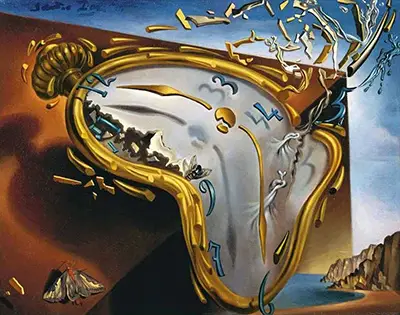His fascinating work, filled with unmistakable visions of the weird and bizarre, are so iconic that the terms surrealist and Daliesque are almost interchangeable. Small wonder that he remains one of the most revered artists in the history of our culture, and will continue to influence new generations of artists for decades, perhaps centuries to come.
Of all the memorably twisted image created by Dali, perhaps the most famous is that of the melting watch. Dali returned to this motif repeatedly, sometimes painting - as in The Persistence of Memory, one of his signature works - an entire field of melting watches.
The painting scene on this page bears he full title of Soft Watch at the Moment of First Explosion, although it is also known under the shorter titles of Clock Explosion or, simply, Melting Watch.
Part of the reason Dali's melting watches stick in our memory is that they take a familiar, day-to-day image of solidity and stability - after all, what could be more regular and reliable than time itself? - and twist it. Time has lost form; our tool for measuring time has melted.
In Soft Watch at the Moment of First Explosion, the watch appears to be doing more than just melting. Fragments are flying out of it, some solid, some liquid; the viewer is witnessing the breakdown of time the very second that it happens.
The melting watch, it is tempting to imagine, is the aftermath of this explosion. Dali's choice of title is typically impish and evocative: Soft Watch at the Moment of First Explosion obviously implies that there will be a second explosion, perhaps more after that. The viewer can only wonder what further distortions of time are in store...
Given the eternal fascination of his work, it is no surprise that art lovers around the world continue to buy prints of Dali's paintings - and the melted watch, as perhaps his single most iconic creation, remains the ideal choice for anybody who wishes to bring a piece of Dali into their home.

